

Trains

Train prints by Currier & Ives
From 1834 to 1907 the firm of Currier & Ives provided for the American people a wide and varied gallery of prints for the new mass market of middle class society. The firm produced prints on every imaginable subject that the American public might find of interest. From mid-century on, the rapid development of railroads was of considerable interest to many Americans; the demand was strong for images of the great engines crossing the country and driving the great expansion of the nation. Currier & Ives met that demand with a series of dramatic trains prints which remain as popular today as they were when first issued.
The following prints, except as noted, are hand colored lithographs, in very good condition, published by Currier & Ives in New York City.
NONE CURRENTLY AVAILABLE.
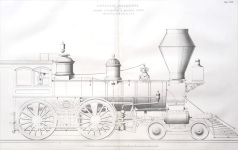
Prints from Zerah Colburn's Locomotive Engineering and the Mechanism of Railways. London & Glasgow: Willam Collins & Sons, 1871. Steel engraving. With fold as issued. Very good condition.
A series of large engravings showing various engines and railroad cars. These came from a Zerah Colburn's history of the steam engine in America, England and on the Continent. This work contained sixty four large engravings. Precisely drawn and engraved, these prints are wonderful pieces of railroadiana.
- "Passenger Locomotive by the Rogers Locomotive and Machine Works, Patterson, New Jersey, U.S." 13 x 20. Left and right margin to edge of image as issued. $625
- "Goods Locomotive by Messrs. Neilson & Co., Hyde Park Locomotive Works, Glasgow." 13 x 193/4. $525
- "Goods Locomotive for the Great Northern Railway of France by M.M. J.I. Gail & Co., Fives-Lille." 13 x 19 1/4. $525
- "Mixed Traffic Engine made by Messrs. Beyer, Peacock & Co., Manchester for the Smyrna & Cassaba Railway." 12 3/4 x 19 3/4. $525
- "Tank Goods Engine by Messrs. Manning, Wardle and Co., Engineers, Leeds." 13 x 20 3/4. Left and right margins trimmed to image. $525
- "Passenger Locomotive for the Stockton & Darlington Railway by Messrs. Robert Stephensen & co., Newcastle Upon Tyne." 13 x 20 3/4. Left and right margins trimmed to image. $525
- "Mixed Traffic Engine for the Window & Annapolis Railway Nova Scotia, Designed and Constructed by Messrs. Fox, Walker & Co., Bristol." 12 x 15 1/4. $500
- "Express Passenger Locomotive Designed by Benjamin Connor, Esq. for the Caledonian Railway made by Messrs. Neilson I Co., Glasgow." 12 3/4 x 19 3/4. $525
Newspaper illustrations
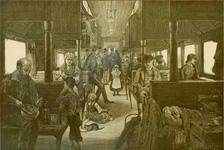
Beginning around the middle of the nineteenth century, newspapers illustrated with wood engravings became hugely popular. The first of this type of newspaper was The Illustrated London News, founded in 1842,and the first American illustrated newspaper was Gleason's Pictorial Drawing-Room Companion, founded in 1851, its name changed to Ballou's Pictorial Drawing-Room Companion in 1855. Frank Leslie's Illustrated Newspaper appeared in 1855, followed two years later by the most successful of all the American illustrated newspapers, Harper's Weekly. The success of these newspapers lay in their illustrations. These prints were wide-ranging in their coverage of events, places, things and persons of interest to the readers, and they were extremely timely in their appearance, often being issued within two weeks of when the images were first drawn. Readers found it new and exciting to be able to have, within days and at an affordable price, a first-hand views of a disaster from across the country, to gaze on an image of a just constructed bridge, or to see contemporary pictures of far-away cities or countries. The rise of these newspapers coincided with the rise of American railroads, so there were numerous illustrations on this subject. These images show many railroad scenes where no other print exists and their timeliness and accuracy, not to mention their affordability, makes them wonderful prints for anyone interested in the subject.
The following prints, except as noted, are uncolored wood engravings in very good condition.
- S.C. McCutcheson. "On an Immigrant Train, Westward Bound." From Harper's Weekly. June 11, 1881. 9 x 13 1/4. $40
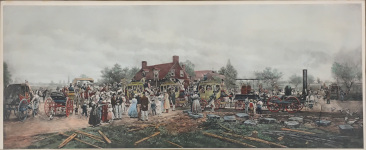

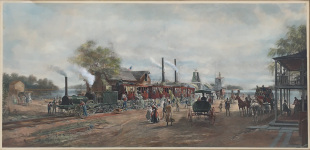
Prints by Edward Lamson Henry. New York: C. Klackner. Photogravures. Printed with color and finished by hand. Very good condition. Framed.
Fascinating historical images of the childhood of rapid transit. These prints are from a series done by C. Klackner depicting some of the most famous early passenger trains. The prints are based on accurate historic information, combining this interesting history with an impressive appearance.
Prints by Otto Kuhler. Etchings. Excellent condition.
Although best known for his industrial designs, Otto Kuhler (1894-1977) is well regarded as a fine artist and draftsman. Born in Germany, Kuhler was the sole heir to his family's successful steel business, Kuhler Forges. After WWI however, the business and his family's fortune were in ruins. After living briefly in Dusseldorf, and partly due to the advice of friend Joseph Pennell, he took up etching and emigrated to the States in 1923. Otto Kuhler's etchings of begrimed industry sprang from the same optimistic response to technology that led to his colorful streamlined designs for the Milwaukee, Lehigh and other railroads in the 1930's. His prints bridge art and industry -- freely-sketched scenes that celebrate precise engineering and industrial might. This merging of industry and art proved so successful that after years of submitting designs, a locomotive based on Kuhler's designs was built. The engine, Hiawatha, rolled out of the Schenectady, New York yard in May, 1935. It was the first streamlined steam locomotive to be built from scratch in America. This signaled the start of the next phase of his career- as a successful industrial designer.
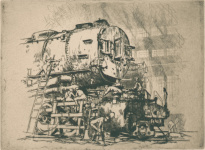
- "Monster & Midgets." 1928. 9 3/8 x 12 7/8. Etching. Signed in pencil. Edition: 75. Excellent condition. $1,200

- "The Boilermakers." 1928. 9 3/8 x 12 3/4. Etching. Signed in pencil. Edition: 75. Excellent condition. $1,500
 Go to page with other twentieth-century travel posters.
Go to page with other twentieth-century travel posters.
 Go to page on railroad maps.
Go to page on railroad maps.









For further information, please contact:


106 E. Lancaster Avenue, Lower Level
Wayne, PA 19087 USA
610.808.6165
PhilaPrint@PhilaPrintShop.com 
©The Philadelphia Print Shop Last updated July 16, 2021








![]()
![]()

![]()
![]()